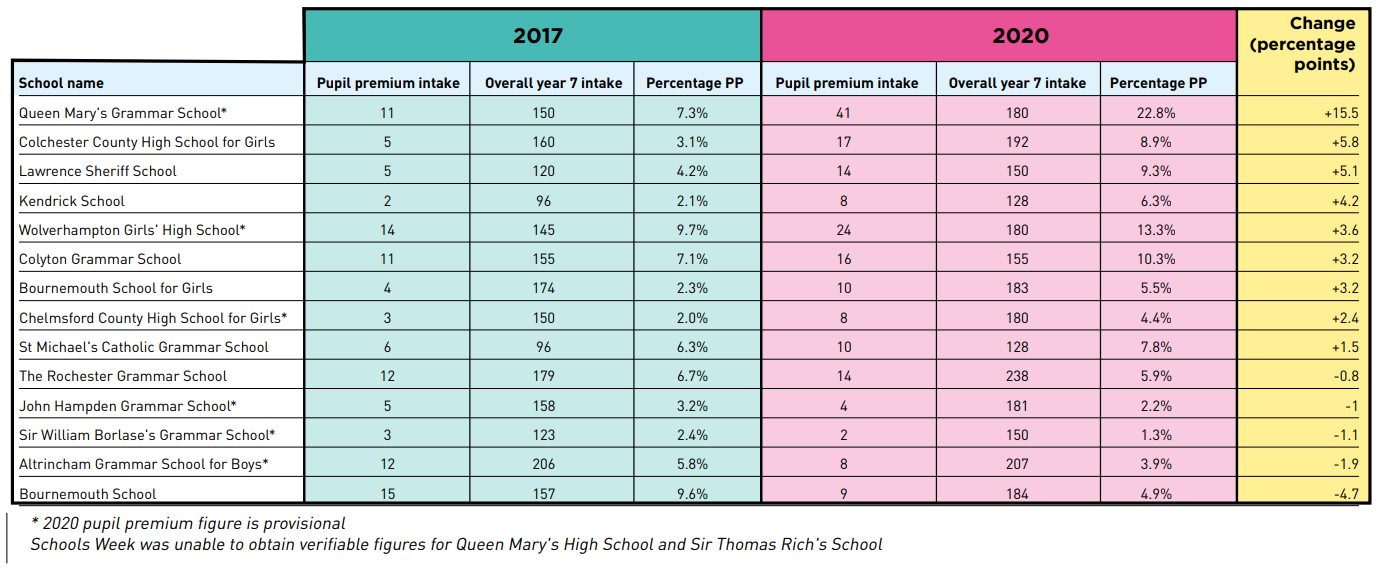The government’s £50 million grammar schools expansion scheme to improve access for poorer pupils has instead created “more places for the middle classes”.
We should be directing precious government resource elsewhere to really improve excellence and equity in the education system
Analysis of admissions data from 14 of the 16 schools that split the selective schools expansion fund (SSEF) shows just 77 additional pupil premium places in three years, despite the number of overall places in those school increasing by 367.
It means each additional place for a disadvantaged pupil has cost more than £630,000.
Schools receiving cash were expected to have “ambitious but deliverable” plans for increasing access. This was the first year such plans came into effect.
But the proportion of pupil premium pupils dropped in five of the schools.
Nuala Burgess, the chair of anti-selection campaign group Comprehensive Future, said the fund “appears to have achieved exactly the opposite of its original purpose: it has provided more grammar school places for the middle classes”.
However, grammar heads said the coronavirus pandemic dented progress by disrupting outreach plans.
Unveiled by ministers in 2016, the SSEF funds expansion in selective schools on the proviso that they become more inclusive. Nick Gibb, the schools minister, claimed that the programme would lead to “significantly more” help for disadvantaged children.
Altrincham Grammar School for Boys (AGSB) in Manchester was aiming to increase pupil premium admissions to 7 per cent by this year.
However, provisional figures show that the proportion of year 7 pupils eligible for the pupil premium fell from 5.8 per cent in 2017 to 3.9 per cent this year.
Graeme Wright, the school’s head, said outreach work “takes time to have an impact and the coronavirus disruptions have hindered our work”. He added the school remained “focused on promoting all the opportunities on offer at AGSB for pupil premium families”.
Rochester Grammar School in Kent pledged to increase the proportion of pupils from deprived backgrounds to 16 per cent by next year. But the proportion of pupil premium pupils in year 7 fell from 6.7 per cent in 2017 to 5.88 per cent this year.
A school spokesperson said: “Our strategy to increase the number of pupil premium students at the school started this month. Its positive impact will therefore clearly not be seen until next year’s year 7 intake.”
Bournemouth School had pledged to prioritise looked-after children and pupil premium pupils, and to change its catchment area to exclude some affluent postcodes.
But the proportion of pupil premium year 7 pupils fell from 9.6 per cent in 2017 to 4.9 per cent this year.
The school has been working with the neighbouring Bournemouth School for Girls (BSG) on its outreach work. The girls’ school has had more success, boosting its pupil premium representation from 2.3 per cent to 5.5 per cent between 2017 and 2020.
But Alistair Brien, BSG’s head, said the coronavirus pandemic had “got in the way” of progress.
“Covid this year has inevitably meant that our summer term programme of sixth-formers going into local primary schools to support year 5s with test preparation has had to be abandoned.”
Michael Stimpson, the head of St Michael’s Catholic Grammar School in Barnet, north London, said his school had been “very limited” in outreach activities this year.
Nevertheless, the proportion of pupil premium pupils rose from 6.3 per cent in 2017 to 7.8 per cent this year.
Other successes include Lawrence Sheriff school in Rugby, Kendrick School in Reading, and Queen Mary’s Grammar School in Walsall – the latter boosted the proportion of pupil premium pupils from 7.3 per cent to 22.8 per cent.
But Ryan Shorthouse, the chief executive of the centre-right think tank Bright Blue, said the data showed that grammar schools “never will be the kind of great engines of social mobility that advocates want them to be.
“We should be directing precious government resource elsewhere to really improve excellence and equity in the education system.”
A Department for Education spokesperson said: “We continue to work with the sector to encourage all grammar schools to do more to increase access for disadvantaged children.”
Nerd note: All 2020 figures are correct as of this week, except for Queen Mary’s Grammar School, Chelmsford County High School in Essex, John Hampden and Sir William Borlase’s, both in Buckinghamshire, which are based on a Comprehensive Future freedom of information request in June and were not updated when the schools were contacted for comment.









Dominic Cummings and Alexander Boris de Pfeffel Johnson will see that as a success.
Keep telling the workers that Tory policy is for their benefit and it appears they will be gullible enough to believe it!
I could cry!